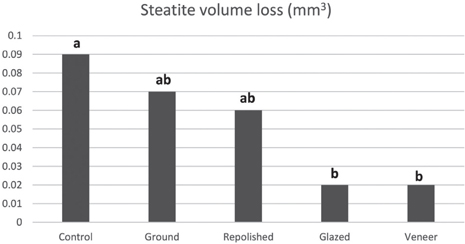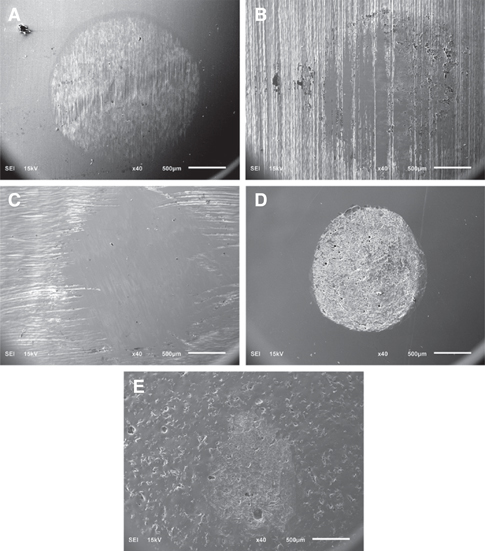J Adv Prosthodont.
2019 Jun;11(3):162-168. 10.4047/jap.2019.11.3.162.
Simulated occlusal adjustments and their effects on zirconia and antagonist artificial enamel
- Affiliations
-
- 1Department of Dental Health, College of Applied Medical Sciences, King Saud University, Riyadh, Saudi Arabia.
- 2Faculty of Dentistry, University of Toronto, Toronto, Canada. grace.desouza@dentistry.utoronto.ca
- KMID: 2450992
- DOI: http://doi.org/10.4047/jap.2019.11.3.162
Abstract
- PURPOSE
The aim of this study was to evaluate the effect of occlusal adjustments on the surface roughness of yttria-tetragonal zirconia polycrystal (Y-TZP) and wear of opposing artificial enamel.
MATERIALS AND METHODS
Twenty-five Y-TZP slabs from each brand (Lava, 3M and Bruxzir, Glidewell Laboratories) with different surface conditions (Control polished - CPZ; Polished/ground - GRZ; Polished/ground/repolished - RPZ; Glazed - GZ; Porcelain-veneered - PVZ; n=5) were abraded (500,000 cycles, 80 N) against artificial enamel (6 mm diameter steatite). Y-TZP roughness (in µm) before and after chewing simulation (CS) and antagonist steatite volume loss (in mm³) were evaluated using a contact surface profilometer. Y-TZP roughness was analyzed by three-way analysis of variance (ANOVA) and teatite wear by two-way ANOVA and Tukey Honest Difference (HSD) (P=.05).
RESULTS
There was no effect of Y-TZP brand on surface roughness (P=.216) and steatite loss (P=.064). A significant interaction effect (P<.001) between surface condition and CS on Y-TZP roughness was observed. GZ specimens showed higher roughness after CS (before CS − 3.7 ± 1.8 µm; after CS − 13.54 ± 3.11 µm), with partial removal of the glaze layer. Indenters abraded against CPZ (0.09 ± 0.03 mm3) were worn more than those abraded against PVZ (0.02 ± 0.01 mm³) and GZ (0.02 ± 0.01 mm³). Higher wear caused by direct abrasion against zirconia was confirmed by SEM.
CONCLUSION
Polishing with an intraoral polishing system did not reduce the roughness of zirconia. Wear of the opposing artificial enamel was affected by the material on the surface rather than the finishing technique applied, indicating that polished zirconia is more deleterious to artificial enamel than are glazed and porcelain-veneered restorations.
Keyword
Figure
Reference
-
1. Tuncel I, Eroglu E, Sari T, Usumez A. The effect of coloring liquids on the translucency of zirconia framework. J Adv Prosthodont. 2013; 5:448–451.
Article2. Beuer F, Stimmelmayr M, Gueth JF, Edelhoff D, Naumann M. In vitro performance of full-contour zirconia single crowns. Dent Mater. 2012; 28:449–456.
Article3. Alghazzawi TF, Janowski GM. Correlation of flexural strength of coupons versus strength of crowns fabricated with different zirconia materials with and without aging. J Am Dent Assoc. 2015; 146:904–912.
Article4. Guess PC, Kulis A, Witkowski S, Wolkewitz M, Zhang Y, Strub JR. Shear bond strengths between different zirconia cores and veneering ceramics and their susceptibility to thermocycling. Dent Mater. 2008; 24:1556–1567.
Article5. Long HA. Monolithic zirconia crowns and bridges. Inside Dent. 2012; 8:60–66.6. Stawarczyk B, Frevert K, Ender A, Roos M, Sener B, Wimmer T. Comparison of four monolithic zirconia materials with conventional ones: Contrast ratio, grain size, four-point flexural strength and two-body wear. J Mech Behav Biomed Mater. 2016; 59:128–138.
Article7. Tong H, Tanaka CB, Kaizer MR, Zhang Y. Characterization of three commercial Y-TZP ceramics produced for their high-translucency, high-strength and high-surface area. Ceram Int. 2016; 42:1077–1085.
Article8. Johansson C, Kmet G, Rivera J, Larsson C, Vult Von Steyern P. Fracture strength of monolithic all-ceramic crowns made of high translucent yttrium oxide-stabilized zirconium dioxide compared to porcelain-veneered crowns and lithium disilicate crowns. Acta Odontol Scand. 2014; 72:145–153.
Article9. Kontos L, Schille C, Schweizer E, Geis-Gerstorfer J. Influence of surface treatment on the wear of solid zirconia. Acta Odontol Scand. 2013; 71:482–487.
Article10. Tholt de Vasconcellos B, Miranda-Júnior WG, Prioli R, Thompson J, Oda M. Surface roughness in ceramics with different finishing techniques using atomic force microscope and profilometer. Oper Dent. 2006; 31:442–449.11. Raigrodski AJ. Concepts of design for contemporary anterior all-ceramic restorations. J Cosme Dent. 2013; 28:46–58.12. Sorrentino R, De Simone G, Tetè S, Russo S, Zarone F. Five-year prospective clinical study of posterior three-unit zirconia-based fixed dental prostheses. Clin Oral Investig. 2012; 16:977–985.
Article13. Candido L, Fais L, Reis JMdSN, Pinelli L. Surface roughness and hardness of yttria stabilized zirconia (Y-TZP) after 10 years of simulated brushing. Rev Odontol UNESP. 2014; 43:379–383.
Article14. Kwon MS, Oh SY, Cho SA. Two-body wear comparison of zirconia crown, gold crown, and enamel against zirconia. J Mech Behav Biomed Mater. 2015; 47:21–28.
Article15. Albashaireh ZS, Ghazal M, Kern M. Two-body wear of different ceramic materials opposed to zirconia ceramic. J Prosthet Dent. 2010; 104:105–113.
Article16. Stawarczyk B, Özcan M, Schmutz F, Trottmann A, Roos M, Hämmerle CH. Two-body wear of monolithic, veneered and glazed zirconia and their corresponding enamel antagonists. Acta Odontol Scand. 2013; 71:102–112.
Article17. Ghazal M, Kern M. The influence of antagonistic surface roughness on the wear of human enamel and nanofilled composite resin artificial teeth. J Prosthet Dent. 2009; 101:342–349.
Article18. Stober T, Bermejo JL, Rammelsberg P, Schmitter M. Enamel wear caused by monolithic zirconia crowns after 6 months of clinical use. J Oral Rehabil. 2014; 41:314–322.19. Preis V, Weiser F, Handel G, Rosentritt M. Wear performance of monolithic dental ceramics with different surface treatments. Quintessence Int. 2013; 44:393–405.20. Preis V, Behr M, Handel G, Schneider-Feyrer S, Hahnel S, Rosentritt M. Wear performance of dental ceramics after grinding and polishing treatments. J Mech Behav Biomed Mater. 2012; 10:13–22.
Article21. Rashid H. The effect of surface roughness on ceramics used in dentistry: A review of literature. Eur J Dent. 2014; 8:571–579.
Article22. Etman MK. Confocal examination of subsurface cracking in ceramic materials. J Prosthodont. 2009; 18:550–559.
Article23. Lawson NC, Janyavula S, Syklawer S, McLaren EA, Burgess JO. Wear of enamel opposing zirconia and lithium disilicate after adjustment, polishing and glazing. J Dent. 2014; 42:1586–1591.
Article24. Jung YS, Lee JW, Choi YJ, Ahn JS, Shin SW, Huh JB. A study on the in-vitro wear of the natural tooth structure by opposing zirconia or dental porcelain. J Adv Prosthodont. 2010; 2:111–115.25. Luangruangrong P, Cook NB, Sabrah AH, Hara AT, Bottino MC. Influence of full-contour zirconia surface roughness on wear of glass-ceramics. J Prosthodont. 2014; 23:198–205.
Article26. Janyavula S, Lawson N, Cakir D, Beck P, Ramp LC, Burgess JO. The wear of polished and glazed zirconia against enamel. J Prosthet Dent. 2013; 109:22–29.
Article27. Steiner M, Mitsias ME, Ludwig K, Kern M. In vitro evaluation of a mechanical testing chewing simulator. Dent Mater. 2009; 25:494–499.
Article28. Kim MJ, Oh SH, Kim JH, Ju SW, Seo DG, Jun SH, Ahn JS, Ryu JJ. Wear evaluation of the human enamel opposing different Y-TZP dental ceramics and other porcelains. J Dent. 2012; 40:979–988.
Article29. Kelly JR. Clinically relevant approach to failure testing of all-ceramic restorations. J Prosthet Dent. 1999; 81:652–661.
Article30. DeLong R, Douglas WH, Sakaguchi RL, Pintado MR. The wear of dental porcelain in an artificial mouth. Dent Mater. 1986; 2:214–219.
Article31. Magne P, Oh WS, Pintado MR, DeLong R. Wear of enamel and veneering ceramics after laboratory and chairside finishing procedures. J Prosthet Dent. 1999; 82:669–679.
Article32. Shortall AC, Hu XQ, Marquis PM. Potential countersample materials for in vitro simulation wear testing. Dent Mater. 2002; 18:246–254.
Article33. Hmaidouch R, Müller WD, Lauer HC, Weigl P. Surface roughness of zirconia for full-contour crowns after clinically simulated grinding and polishing. Int J Oral Sci. 2014; 6:241–246.
Article34. Ablal MA, Kaur JS, Cooper L, Jarad FD, Milosevic A, Higham SM, Preston AJ. The erosive potential of some alcopops using bovine enamel: an in vitro study. J Dent. 2009; 37:835–839.
Article35. Lameira DP, Buarque e Silva WA, Andrade e Silva F, De Souza GM. Fracture strength of aged monolithic and bilayer zirconia-based crowns. Biomed Res Int. 2015; 2015:418641.
Article36. Ludovichetti FS, Trindade FZ, Werner A, Kleverlaan CJ, Fonseca RG. Wear resistance and abrasiveness of CAD-CAM monolithic materials. J Prosthet Dent. 2018; 120:318.e1–318.e8.
Article37. Pereira GKR, Guilardi LF, Dapieve KS, Kleverlaan CJ, Rippe MP, Valandro LF. Mechanical reliability, fatigue strength and survival analysis of new polycrystalline translucent zirconia ceramics for monolithic restorations. J Mech Behav Biomed Mater. 2018; 85:57–65.
Article38. Barghi N, Alexander L, Draughn RA. When to glaze - An electron microscope study. J Prosthet Dent. 1976; 35:648–653.39. Roselino Lde M, Cruvinel DR, Chinelatti MA, Pires-de-Souza Fde C. Effect of brushing and accelerated ageing on color stability and surface roughness of composites. J Dent. 2013; 41:e54–e61.40. Tortopidis D, Lyons MF, Baxendale RH, Gilmour WH. The variability of bite force measurement between sessions, in different positions within the dental arch. J Oral Rehabil. 1998; 25:681–686.
Article41. Aydın B, Pamir T, Baltaci A, Orman MN, Turk T. Effect of storage solutions on microhardness of crown enamel and dentin. Eur J Dent. 2015; 9:262–266.
Article42. Camposilvan E, Leone R, Gremillard L, Sorrentino R, Zarone F, Ferrari M, Chevalier J. Aging resistance, mechanical properties and translucency of different yttria-stabilized zirconia ceramics for monolithic dental crown applications. Dent Mater. 2018; 34:879–890.
Article43. Pinto PA, Colas G, Filleter T, De Souza GM. Surface and mechanical characterization of dental yttria-stabilized tetragonal zirconia polycrystals (3Y-TZP) after different aging processes. Microsc Microanal. 2016; 22:1179–1188.
Article
- Full Text Links
- Actions
-
Cited
- CITED
-
- Close
- Share
- Similar articles
-
- 3D quantitative analysis and SEM qualitative analysis of natural antagonist enamel opposing CAD-CAM monolithic zirconia or lithium disilicate tooth-supported crowns versus enamel opposing natural enamel
- Evaluation of intaglio surface trueness, wear, and fracture resistance of zirconia crown under simulated mastication: a comparative analysis between subtractive and additive manufacturing
- Comparison of occusal aspects in monolithic zirconia crown before and after occlusal adjustment during intraoral try-in: a case report
- Comparative analysis on intaglio surface trueness, wear volume loss of antagonist, and fracture resistance of full-contour monolithic zirconia crown for single-visit dentistry under simulated mastication
- Superimposition: a simple method to minimize occlusal adjustment of monolithic restoration





